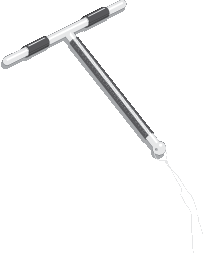Overview of intrauterine contraceptive device (IUCD)
The IUCD (see figure below) is a small object or device that is inserted into the womb by a specially trained health worker or midwife. Once in the womb, the IUD prevents the man's sperm from fertilising the woman's egg. The IUD can stay in the womb for up to 10 or 12 years (depending on the kind of IUD it is) before it must be removed and replaced.IUDs are highly effective in providing long-term, reversible contraception.


How effective are IUDs?:
IUD is one of the most effective contraceptive methods with an efficacy of nearly 100%. Pregnancy (failure) rate during the first year of use is less than one pregnancy for 100 women. Continuation rates and client satisfaction are also high. Also, fertility returns soon after removal. Furthermore, IUCD is a good option for those who have to take medical precautions using hormonal methods, as there are no hormonal side effects with copper-bearing IUCDs. It does not interact with any medicine the client may be taking, so it is ideal for those who are taking antiepileptic or anti-tuberculosis medications.
Who Can Use IUCDs?:
Most women can use the Copper T IUD safely, including women who:
- Have or have not had children.
- Are not married.
- Are of any age.
- Have just had an abortion or miscarriage (no infection).
- Are breastfeeding.
- Have had PID.
- Have vaginal infections.
- Are infected with HIV or have AIDS and on ARVs.
Who can not use IUCDs?:
Not appropriate for women:-
- With pregnancy (known or suspected).
- With unexplained vaginal bleeding.
- Who is postpartum between 48hrs-4wks.
- With current pelvic infection.
- With AIDS cases (clinically not well).
When can IUD be inserted?:
- Having menstrual cycles - If starting within 12 days after the start of her monthly bleeding, no need for a backup method. If it is more than 12 days after the start of her monthly bleeding, she can have the IUD inserted any time it is reasonably sure she is not pregnant. No need for a backup method.
- Switching from another method- immediately if the client has been using the previous method consistently and correctly or if otherwise reasonably certain she is not pregnant. No need to wait for a next monthly bleeding.
- For emergency contraception, within five days after unprotected intercourse. After taking emergency contraceptive pills (ECPs) (you will see in detail ECP in the next module), the same day that she finishes taking ECPs.
- No monthly bleeding - Any time if it can be determined she is not pregnant.
- Postpartum:
- Any time within 48 hours after giving birth (requires a provider with specific training in postpartum insertion) or after four weeks after giving birth.
- Fully or nearly fully breastfeeding - If her monthly bleeding has not returned anytime between 4 weeks and 6 months after childbirth. If more than 6 months after giving birth, any time it is reasonably certain she is not pregnant. No need for a backup method.
- Partially breastfeeding or not breastfeeding - If more than four weeks since giving birth and her monthly bleeding have not returned, IUD can be inserted if it can be determined she is not pregnant. No need for a backup method.
- Breastfeeding and monthly bleeding have returned - as advised for women having menstrual cycles.
- Post abortion (after abortion or miscarriage) immediately or within 12 days if no infection is present. Beyond 12 days after abortion or miscarriage, anytime it is reasonably sure that she is not pregnant. If an infection is present, after the infection has completely cleared.
How are IUDs inserted and removed?:
You will not be expected to insert or remove IUCDs. These procedures should be performed only by service providers who have been trained, such as physicians, nurses and midwives. However, it is important for you to understand counselling clients on available options and refer to nearby health facilities if the woman chooses the method.
Side effects (that are temporary and not dangerous):
Changes in bleeding patterns (especially in the first 3 to 6 months) including:
- Prolonged and heavy monthly bleeding, irregular bleeding, more cramps and pain during monthly bleeding are expected with copper IUDs and usually become less over time.
- May contribute to anaemia if a woman already has low iron blood stores before insertion and the IUD causes heavier monthly bleeding
- Pelvic inflammatory disease (PID) may occur if the woman has Chlamydia or gonorrhoea at the time of IUD insertion.